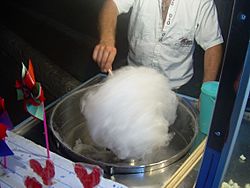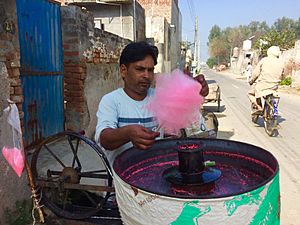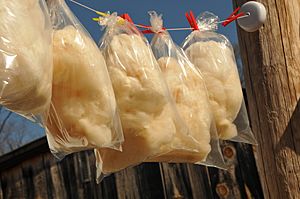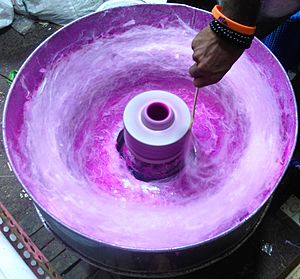Cotton candy facts for kids

Spinning cotton candy at a fair
|
|
| Alternative names | Fairy floss; candy floss |
|---|---|
| Type | Confectionery |
| Place of origin | United States |
| Created by | William Morrison and John C. Wharton |
| Main ingredients | Sugar, food coloring |
Cotton candy, also known as fairy floss or candy floss, is a sweet treat made from sugar. It looks a lot like fluffy cotton. This yummy snack often has a little bit of flavor or food coloring added to it.
To make cotton candy, sugar is heated until it melts into a liquid. Then, it's spun very fast through tiny holes. This spinning motion cools the sugar quickly, turning it into fine, thin strands. You can often find cotton candy sold at fairs, circuses, and festivals. It's usually served in a plastic bag, on a stick, or on a paper cone.
Cotton candy is popular all over the world! In the UK, Ireland, India, New Zealand, Sri Lanka, and South Africa, it's called candy floss. In Australia, it's known as fairy floss. Other similar sweets include kkul-tarae from Korea and pashmak from Persia.
Contents
The Sweet Story of Cotton Candy
Many people believe that cotton candy, or a similar spun sugar treat, first appeared in Europe in the 1800s. Back then, making spun sugar was very difficult and expensive. This meant that only wealthy people could enjoy it. Some even think that versions of spun sugar might have existed in Italy as far back as the 1400s!
Who Invented Machine-Spun Cotton Candy?
The cotton candy we know today was invented in 1897. A dentist named William Morrison and a candy maker named John C. Wharton created the first machine-spun cotton candy. They first showed it to a large crowd at the 1904 World's Fair. It was called "Fairy Floss" and was a huge hit! They sold 68,655 boxes, each costing 25 cents.
Later, in 1921, another dentist named Joseph Lascaux from New Orleans, Louisiana, invented a similar machine. He gave the sweet treat the name "cotton candy." This name eventually became more popular than "fairy floss," though it's still called fairy floss in Australia.
How Cotton Candy Became Easier to Make
In the 1970s, an amazing invention changed cotton candy production. An automatic cotton candy machine was created! This machine could make the product and even package it. This made it much easier to produce cotton candy at carnivals, stalls, and other events where you need to make a lot quickly.
Did you know that Tootsie Roll Industries, a very famous candy company, makes a bagged, fruit-flavored cotton candy called Fluffy Stuff? Also, in the United States, people celebrate National Cotton Candy Day every year on December 7th!
How Cotton Candy is Made

Making cotton candy is quite interesting! The machines used have a spinning head with a small "sugar reserve" bowl inside. You pour granulated (grainy) sugar, which might already be colored, into this bowl.
Heaters around the edge of the spinning head melt the sugar. As the head spins super fast, the melted sugar is pushed out through tiny holes. When the hot, melted sugar hits the cooler air, it quickly turns back into solid, fine strands.
These sugar strands are caught in a larger bowl that surrounds the spinning head. As more and more cotton-like sugar builds up, the machine operator uses a stick or cone. They twirl it around the inside of the large bowl, gathering the sugar strands into a fluffy portion. This is how you get your cotton candy on a stick or in a bag! When the sugar bowl gets empty, the operator simply adds more sugar.
Cotton candy can be a bit tricky to make in very humid places, especially in summer. The humidity can make the process messy and sticky.
Modern Cotton Candy Machines
Today, there are even more advanced ways to make cotton candy. In Taiwan, vending machines have been developed that can automatically make single servings of cotton candy. You can also find lighted or glowing sticks to hold your cotton candy, which makes it even more fun!
Cotton Candy Colors and Flavors
The sugar used to make cotton candy usually has both color and flavor added to it. When it's spun, cotton candy is naturally white because it's made from sugar. But adding dye or coloring changes its color! Originally, cotton candy was only white.
In the US, cotton candy comes in many flavors. However, two colors and flavors are most common: blue raspberry and pink vanilla. These were first created by a brand called Gold Medal.
The Taste of Cotton Candy
Often, once cotton candy is spun, it's just sold by its color. For example, "blue cotton candy." The unique taste of blue raspberry cotton candy has become so famous that other foods sometimes use it! You might find "cotton-candy flavored" ice cream or gum. This helps bring back fun memories of eating cotton candy.
The sale of blue cotton candy at fairs in the 1950s was one of the first times blue-raspberry flavoring was widely used in America. It's a bit like how pink bubble gum became a general flavor that you can find in many different sweets.
Cotton Candy Machine Sizes
In 1978, the first automatic machine for making cotton candy was used. Since then, many different types of machines have been made. They range in size from small ones that fit on a counter to large machines for parties and carnivals. Modern commercial machines can hold up to 3 pounds (about 1.4 kg) of sugar. They also have storage for extra flavors and bowls that spin incredibly fast, at 3,450 rotations per minute!
See also
 In Spanish: Algodón de azúcar para niños
In Spanish: Algodón de azúcar para niños




